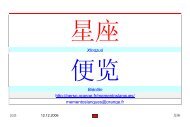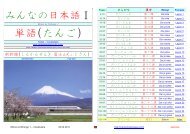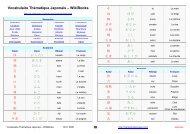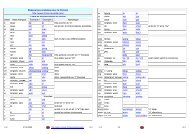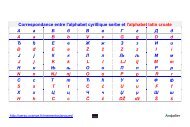Ordre du tracé des traits des 103 Kanji du JLPT4 hito(tsu) ICHI/ITSU ...
Ordre du tracé des traits des 103 Kanji du JLPT4 hito(tsu) ICHI/ITSU ...
Ordre du tracé des traits des 103 Kanji du JLPT4 hito(tsu) ICHI/ITSU ...
You also want an ePaper? Increase the reach of your titles
YUMPU automatically turns print PDFs into web optimized ePapers that Google loves.
<strong>Ordre</strong> <strong>du</strong> <strong>tracé</strong> <strong>des</strong> <strong>traits</strong> <strong>des</strong> <strong>103</strong> <strong>Kanji</strong> <strong>du</strong> <strong>JLPT4</strong><br />
<strong>hito</strong>(<strong>tsu</strong>) <strong>ICHI</strong>/<strong>ITSU</strong> KJ1<br />
futa(<strong>tsu</strong>) NI KJ2<br />
mi(<strong>tsu</strong>)/mit(<strong>tsu</strong>) SAN KJ3<br />
yon/yo(<strong>tsu</strong>)/yot(<strong>tsu</strong>) SHI KJ4<br />
i<strong>tsu</strong>(<strong>tsu</strong>) GO KJ5<br />
mu(<strong>tsu</strong>)/mut(<strong>tsu</strong>)/mui ROKU KJ6<br />
nana(<strong>tsu</strong>)/nano SH<strong>ICHI</strong> KJ7<br />
ya(<strong>tsu</strong>)/yat(<strong>tsu</strong>)/you HACHI KJ8<br />
kokono(<strong>tsu</strong>) KYŪ/KU KJ9<br />
<strong>Ordre</strong> <strong>du</strong> <strong>tracé</strong> <strong>des</strong> <strong>traits</strong> <strong>des</strong> <strong>Kanji</strong> 09.07.2007 http://mementoslangues.com/ <strong>JLPT4</strong>
to/tō JŪ KJ10<br />
HYAKU<br />
KJ11<br />
chi SEN/ZEN KJ12<br />
MAN/BAN<br />
KJ13<br />
chichi/tou FU KJ14<br />
haha/kā BO KJ15<br />
tomo YŪ KJ16<br />
onna JO KJ17<br />
otoko DAN KJ18<br />
<strong>Ordre</strong> <strong>du</strong> <strong>tracé</strong> <strong>des</strong> <strong>traits</strong> <strong>des</strong> <strong>Kanji</strong> 2/18 http://mementoslangues.com/ <strong>JLPT4</strong>
<strong>hito</strong> JIN/NIN KJ19<br />
ko SHI KJ20<br />
hi/ka J<strong>ITSU</strong>/N<strong>ICHI</strong> KJ21<br />
<strong>tsu</strong>ki<br />
GATSU/GETSU KJ22<br />
hi KA KJ23<br />
mizu SUI KJ24<br />
ki MOKU/BOKU KJ25<br />
kane KIN/KON KJ26<br />
<strong>tsu</strong>chi DO/TO KJ27<br />
<strong>Ordre</strong> <strong>du</strong> <strong>tracé</strong> <strong>des</strong> <strong>traits</strong> <strong>des</strong> <strong>Kanji</strong> 3/18 http://mementoslangues.com/ <strong>JLPT4</strong>
moto HON KJ28<br />
yasu(mi/mu) KYŪ KJ29<br />
toshi NEN KJ31<br />
GO<br />
KJ32<br />
mae ZEN KJ33<br />
ushi(ro)/nochi/ato GO/KOU KJ34<br />
goto MAI KJ37<br />
saki SEN KJ38<br />
ima KON/KIN KJ39<br />
<strong>Ordre</strong> <strong>du</strong> <strong>tracé</strong> <strong>des</strong> <strong>traits</strong> <strong>des</strong> <strong>Kanji</strong> 4/18 http://mementoslangues.com/ <strong>JLPT4</strong>
nani/nan KA KJ40<br />
ue/a(geru) JŌ KJ41<br />
shita/shimo KA/GE KJ42<br />
hidari SA KJ43<br />
migi YŪ/U KJ44<br />
kita HOKU KJ45<br />
minami NAN KJ46<br />
higashi TOU KJ47<br />
nishi SEI/SAI KJ48<br />
<strong>Ordre</strong> <strong>du</strong> <strong>tracé</strong> <strong>des</strong> <strong>traits</strong> <strong>des</strong> <strong>Kanji</strong> 5/18 http://mementoslangues.com/ <strong>JLPT4</strong>
hoka/soto GAI/GE KJ49<br />
na MEI/MYOU KJ50<br />
ko/o/chii(sai) SHOU KJ52<br />
naka CHUU KJ53<br />
ō(kii) DAI/TAI KJ54<br />
naga(i) CHOU KJ55<br />
naka(ba) HAN KJ56<br />
wa(keru)/wa(karu) BUN/FUN KJ57<br />
mana(bu) GAKU KJ60<br />
<strong>Ordre</strong> <strong>du</strong> <strong>tracé</strong> <strong>des</strong> <strong>traits</strong> <strong>des</strong> <strong>Kanji</strong> 6/18 http://mementoslangues.com/ <strong>JLPT4</strong>
yama SAN KJ61<br />
kawa SEN KJ62<br />
shira/shiro(i) HAKU/BYAKU KJ63<br />
ama/ame TEN KJ64<br />
KI/KE<br />
KJ67<br />
kuruma SHA KJ68<br />
maru(i) EN KJ70<br />
ku(u)/ta(beru) JIKI/SHOKU KJ73<br />
ku(ru) RAI KJ75<br />
<strong>Ordre</strong> <strong>du</strong> <strong>tracé</strong> <strong>des</strong> <strong>traits</strong> <strong>des</strong> <strong>Kanji</strong> 7/18 http://mementoslangues.com/ <strong>JLPT4</strong>
mi(ru)/mi(seru) KEN KJ77<br />
i(ku), yu(ku) KOU/GYOU KJ78<br />
da(su)/de(ru) SHUTSU KJ79<br />
i(ru)/hai(ru) NYŪ KJ80<br />
a(u) KAI KJ81<br />
kuchi KŌ/KU KJ82<br />
furu(i) KO KJ83<br />
ō(i) TA KJ84<br />
yasu(i) AN KJ85<br />
<strong>Ordre</strong> <strong>du</strong> <strong>tracé</strong> <strong>des</strong> <strong>traits</strong> <strong>des</strong> <strong>Kanji</strong> 8/18 http://mementoslangues.com/ <strong>JLPT4</strong>
suku(nai)/suko(shi) SHŌ KJ86<br />
mise TESO KJ87<br />
te SHU KJ88<br />
me MOKU(BOKU) KJ90<br />
yashiro SHA KJ91<br />
sora/a(ku)/kara KŪ KJ92<br />
ta(<strong>tsu</strong>)/tate(ru) R<strong>ITSU</strong> KJ93<br />
mimi JI KJ94<br />
hana KA KJ95<br />
<strong>Ordre</strong> <strong>du</strong> <strong>tracé</strong> <strong>des</strong> <strong>traits</strong> <strong>des</strong> <strong>Kanji</strong> 9/18 http://mementoslangues.com/ <strong>JLPT4</strong>
ka(u) GUN/GON KJ97<br />
ashi/tari(ru)/ta(<strong>tsu</strong>) SOKU KJ98<br />
katari/kata(ru) GO KJ30<br />
toki JI KJ35<br />
aida/ma KAN/KEN KJ36<br />
taka(i) KOU KJ51<br />
<strong>Ordre</strong> <strong>du</strong> <strong>tracé</strong> <strong>des</strong> <strong>traits</strong> <strong>des</strong> <strong>Kanji</strong> 10/18 http://mementoslangues.com/ <strong>JLPT4</strong>
mana(bu) GAKU KJ58<br />
KOU<br />
KJ59<br />
ama/ame U KJ65<br />
DEN<br />
KJ66<br />
kuni KOKU KJ69<br />
<strong>Ordre</strong> <strong>du</strong> <strong>tracé</strong> <strong>des</strong> <strong>traits</strong> <strong>des</strong> <strong>Kanji</strong> 11/18 http://mementoslangues.com/ <strong>JLPT4</strong>
hanashi/hana(su) WA KJ71<br />
ki(ku) BUN KJ72<br />
yo(mu) DOKU KJ74<br />
ka(ku) SHO KJ76<br />
atarashi(i)/arata SHIN KJ89<br />
<strong>Ordre</strong> <strong>du</strong> <strong>tracé</strong> <strong>des</strong> <strong>traits</strong> <strong>des</strong> <strong>Kanji</strong> 12/18 http://mementoslangues.com/ <strong>JLPT4</strong>
買<br />
ka(u) BAI KJ96<br />
週<br />
shū SHŪ KJ99<br />
駅<br />
eki EKI KJ100<br />
michi DŌ KJ101<br />
飲<br />
no(mu) IN KJ102<br />
<strong>Ordre</strong> <strong>du</strong> <strong>tracé</strong> <strong>des</strong> <strong>traits</strong> <strong>des</strong> <strong>Kanji</strong> 13/18 http://mementoslangues.com/ <strong>JLPT4</strong>
sakana/uo GYO KJ<strong>103</strong><br />
日 本 語 能 力 試 験 4 級<br />
Nihongo Nōryoku Shiken Yon-Kyū<br />
Japanese Language Proficiency Test Level 4 <strong>JLPT4</strong><br />
Les <strong>103</strong> <strong>Kanji</strong> <strong>du</strong> Japanese Language Proficiency Test Level 4 (<strong>JLPT4</strong>)<br />
万 千 百 十 九 八 七 六 五 四 三 二 一<br />
KJ13 KJ12 KJ11 KJ10 KJ9 KJ8 KJ7 KJ6 KJ5 KJ4 KJ3 KJ2 KJ1<br />
金 木 水 火 月 日 子 人 男 女 友 母 父<br />
KJ26 KJ25 KJ24 KJ23 KJ22 KJ21 KJ20 KJ19 KJ18 KJ17 KJ16 KJ15 KJ14<br />
今 先 毎 間 時 後 前 午 年 語 休 本 土<br />
KJ39 KJ38 KJ37 KJ36 KJ35 KJ34 KJ33 KJ32 KJ31 KJ30 KJ29 KJ28 KJ27<br />
小 高 名 外 西 東 南 北 右 左 下 上 何<br />
KJ52 KJ51 KJ50 KJ49 KJ48 KJ47 KJ46 KJ45 KJ44 KJ43 KJ42 KJ41 KJ40<br />
雨 天 白 川 山 生 校 学 分 半 長 大 中<br />
KJ65 KJ64 KJ63 KJ62 KJ61 KJ60 KJ59 KJ58 KJ57 KJ56 KJ55 KJ54 KJ53<br />
行 見 書 来 読 食 聞 話 円 国 車 気 電<br />
KJ78 KJ77 KJ76 KJ75 KJ74 KJ73 KJ72 KJ71 KJ70 KJ69 KJ68 KJ67 KJ66<br />
社 目 新 手 店 少 安 多 古 口 会 入 出<br />
KJ91 KJ90 KJ89 KJ88 KJ87 KJ86 KJ85 KJ84 KJ83 KJ82 KJ81 KJ80 KJ79<br />
ML<br />
Memo<br />
魚 飲 道 駅 週 足 言 買 花 耳 立 空<br />
2007 KJ<strong>103</strong> KJ102 KJ101 KJ100 KJ99 KJ98 KJ97 KJ96 KJ95 KJ94 KJ93 KJ92<br />
<strong>Ordre</strong> <strong>du</strong> <strong>tracé</strong> <strong>des</strong> <strong>traits</strong> <strong>des</strong> <strong>Kanji</strong> 14/18 http://mementoslangues.com/ <strong>JLPT4</strong>
<strong>Kanji</strong> Stroke Order<br />
http://infohost.nmt.e<strong>du</strong>/~armiller/japanese/strokeorder.htm<br />
General rules for <strong>Kanji</strong> stroke order are given below along with examples. Red dots show the beginning of each<br />
stroke. The stroke count, 画 , is also given.<br />
1. Left to right and top to bottom<br />
The most basic rule is that indivi<strong>du</strong>al strokes are drawn from from left to right and from top to bottom.<br />
2. A set of horizontal lines is drawn from top to bottom<br />
Each stroke is drawn from left to right and placed from top to bottom.<br />
For example, the order for three, 三 (3 画 ) and say 言 (7 画 ) is:<br />
3. A set of vertical strokes is written from left to right<br />
Each stroke is drawn from top to bottom and placed from left to right.<br />
For example, the order for river 川 (3 画 ) and state 州 (6 画 ) is:<br />
4. Center verticals before outside strokes wings<br />
Draw the center stroke first when there are left, right strokes. Then draw the left strokes.<br />
For example, the order for water 水 (4 画 ) and thread 糸 (6 画 ) is:<br />
5. Horizontal before vertical<br />
When strokes cross, the horizontal strokes are usually written first.<br />
For example, the order for ten 十 (2 画 ) is:<br />
<strong>Kanji</strong> Stroke Order 15/18 http://mementoslangues.com/ <strong>Kanji</strong>
Except for bottom stroke<br />
If there is a horizontal bottom stroke, the vertical stroke is drawn eariler.<br />
For example, the order for King 王 (4 画 ) is:<br />
6. Outside before inside<br />
Outside parts are drawn first,starting with the left vertical. However a bottom stroke is drawn last.<br />
For example, the order for sun 日 (4 画 ), rice field 田 (5 画 ), and country 国 (8 画 ) is:<br />
Except open box on right<br />
If the box is open on the right side, then the left and bottom stroke is drawn last.<br />
For example, the order for ward 区 (4 画 ) is:<br />
Right-to-left before left-to-right diagonals<br />
A right-to-left diagonal stroke comes before a left-to-right diagonal stroke.<br />
For example, the order for person 人 (2 画 ) and Sentence 文 (4 画 ) is:<br />
<strong>Kanji</strong> Stroke Order 16/18 http://mementoslangues.com/ <strong>Kanji</strong>
7. Horizontal crossing right-to-left diagonal is inconsistent<br />
The order of a horizontal stroke crossing a right-to-left diagonal stroke is inconsistent. The horizontal<br />
stroke sometimes comes first and sometimes second. In either case, the second stroke is longer than the<br />
first.<br />
For example, the order for right 右 (5 画 ) and left 左 (5 画 ) is:<br />
8. The horizontal stroke comes first for power 力 (2 画 ) but second for nine 九 (2 画 ):<br />
9. Right-to-left diagonal<br />
Watch for gently sloping right-to-left diagonal that looks like horizontal stroke.<br />
For example, the order for thousand 千 (3 画 ) is:<br />
10. Vertical cutting strokes are last<br />
A central vertical stroke comes last.<br />
For example, the order for middle 中 (4 画 ) and for half 半 (5 画 ) is:<br />
11. Horizontal cutting strokes are last<br />
A central horizontal stroke comes last.<br />
For example, the order for woman 女 (3 画 ), mama 母 (5 画 ), and boat 舟 (6 画 ) is:<br />
<strong>Kanji</strong> Stroke Order 17/18 http://mementoslangues.com/ <strong>Kanji</strong>
But horizontal stroke comes first for large 大 (3 画 ):<br />
12. Road radical is last<br />
The road radical, the lower part of near 近 , (7 画 ) comes last.<br />
Here are the strokes:<br />
13. Gate radical starts at left<br />
The left vertical stroke of the gate radical is drawn before the parts to the right 門 , (8 画 ).<br />
Here are the strokes:<br />
14. Food radical moves left<br />
The left vertical stroke of the food radical is drawn after the parts to the right 食 , (9 画 ).<br />
Here are the strokes:<br />
<strong>Kanji</strong> Stroke Order 18/18 http://mementoslangues.com/ <strong>Kanji</strong>



